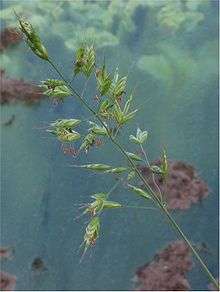Bromus hordeaceus
| Bromus hordeaceus | |
|---|---|
 | |
| Scientific classification | |
| Kingdom: | Plantae |
| (unranked): | Angiosperms |
| (unranked): | Monocots |
| (unranked): | Commelinids |
| Order: | Poales |
| Family: | Poaceae |
| Genus: | Bromus |
| Species: | B. hordeaceus |
| Binomial name | |
| Bromus hordeaceus | |
| Synonyms | |
|
Bromus mollis | |
Bromus hordeaceus, soft brome, is an annual or biennial species of grass in the true grass family (Poaceae). It is also known in North America as bull grass, soft cheat, and soft chess.
It is the most common species of Bromus in Britain, where it can be found on roadsides, waste ground, meadows, and cultivated land. It is found throughout Europe and western Asia, and was introduced into North and South America and Australia.
Previously known as B. mollis,[1] his species belongs to a group of closely related species, including some hybrids, which are difficult to tell apart. Some of the other species in this group include: B. thominii, B. lepidus, B. ferronii, and B. molliformis.[2]
Description
The plant is hairy all over. It can grow between 10 and 100 cm high, sometimes in tufts, sometimes singly. The culms have between 2 and 5 nodes. The leaves are grey-green. The ligules are 2.5 mm high and flat but toothed. The panicles are up to 16 cm long and grey-green to purple. The spikelets have awns, 3-8 mm[3]. It grows during winter and flowers from late spring onwards maturing in the summer[4].
Invasive species
This brome grass can be a weed in cereal crops. It grows in wheat and spring barley crops competing and reducing their yield. Besides, the seeds can contaminate the crop seeds and lower seed quality [4].
Control and management
There are very few herbicides that selectively control soft brome in wheat or barley. The management of this weed is mostly based on an integrated programme. This includes hygiene to minimise its introduction to the fields as well as cleaning the fence lines where the infestation is more severe. A good crop rotation is useful as B. hordeaceus can be controlled with several herbicides in most other crops in the rotation. Growers in New Zealand use stubble burning to reduce the seed input in the following crops [4].
Subspecies
- Bromus hordeaceus ssp. ferronii – least soft brome
- Bromus hordeaceus ssp. hordeaceus
- Bromus hordeaceus ssp. molliformis
- Bromus hordeaceus ssp. pseudothominii
- Bromus hordeaceus ssp. thominei – lesser soft brome
References
- ↑ kh02kg. "RBG Kew: GrassBase - Bromus hordeaceus Description". www.kew.org. Retrieved 2018-02-27.
- ↑ Hubbard, C. E. Grasses. Penguin Books. 1978.
- ↑ Edgar E. & Connor H.E. (2000). Flora of New Zealand, Vol. V, Grasses. Manaaki Whenua Press, Lincoln, New Zealand. p. 362-3
- 1 2 3 Dastgheib F. & Poole N. (2010). Seed biology of brome grass weeds (Bromus diandrus and B. hordeaceus) and effects of land management, “New Zealand Plant Protection” 63: 78-83
External links
- Jepson Manual Treatment
- USDA Plants Profile
- UCD IPM Weeds Gallery
- Forest Service Fire Ecology
- Photo gallery
| Wikimedia Commons has media related to Bromus hordeaceus. |